Table of Contents
- 1 Introduction
- 2 How to Clean Stainless Steel Jewelry
- 3 Fun Facts About Stainless Steel Jewelry
- 4 How Often to Clean Stainless Steel Jewelry
- 5 What You’ll Need To Clean Your Stainless Steel Jewelry
- 6 Cleaning With Soap and Water
- 7 Cleaning With Baking Soda
- 8 Cleaning With Toothpaste
- 9 Cleaning With Homemade Cleaner
- 10 Cleaning With Aluminium Foil
- 11 Cleaning With Vinegar
- 12 How to Care for Stainless Steel Jewelry
- 13 Stainless Steel Jewelry Care FAQs
Introduction
There are several pieces of stainless steel jewelry, such as wedding bands, watches, and earrings. Since stainless steel is more affordable, robust, and long-lasting than silver, gold, or platinum, jewelers prefer it. In addition, the metal is easily cleaned and resistant to rust.
Uncover how to maintain the cleanliness of your stainless steel jewelry with some items you probably already have with the following subtopics below;
How to Clean Stainless Steel Jewelry
Let’s start with how you can perfectly clean the stainless steel jewelry you own.
Did you know that common home cleaners can effectively clean stainless steel jewelry? Additionally, you can use different techniques to clean the surfaces of your stainless steel appliances, such as dishwashers and refrigerator doors.
Although you can’t soak them in a cleaning solution, you can still make those larger stainless surfaces sparkle by using the mixture on a cloth and wiping it off.
You may develop simple DIY remedies for a fraction of the cost and avoid spending a fortune on pricey cleaners. There are also no unpleasant vapors to be concerned about.
Fun Facts About Stainless Steel Jewelry
An alloy of iron and chromium is called stainless steel. The precise constituents and proportions of the metal will change according to the steel’s intended application.
When Rolex released the Submariner stainless steel model in 1950, it started making stainless steel watches in the 1920s, creating a stir.
When worn close to the skin, stainless steel jewelry is nonreactive and hypoallergenic.
When polished, stainless steel can resemble platinum and white gold jewelry quite a bit. It can be plated in gold as well.
There are still many fun facts about stainless steel jewelry, but the next sub-topic is important for you to learn how to clean your stainless steel jewelry frequently.
Read More:
- Does Stainless Steel Jewelry Tarnish
- Pros and Cons of Stainless Steel Jewelry
- 10 Best Stainless Steel Jewelry Wholesale Suppliers
How Often to Clean Stainless Steel Jewelry
The frequency of exposure of stainless steel jewelry greatly influences the cleaning schedule. Although jewelry made of stainless steel can not rust, tarnish from minor scratches and pollutants can cause it to become dull.
Give your jewelry a thorough cleaning if it has lost its shine. It must be cleaned immediately if stainless steel jewelry comes into contact with a lot of grime, oil, or abrasive substances like bleach.
What You’ll Need To Clean Your Stainless Steel Jewelry
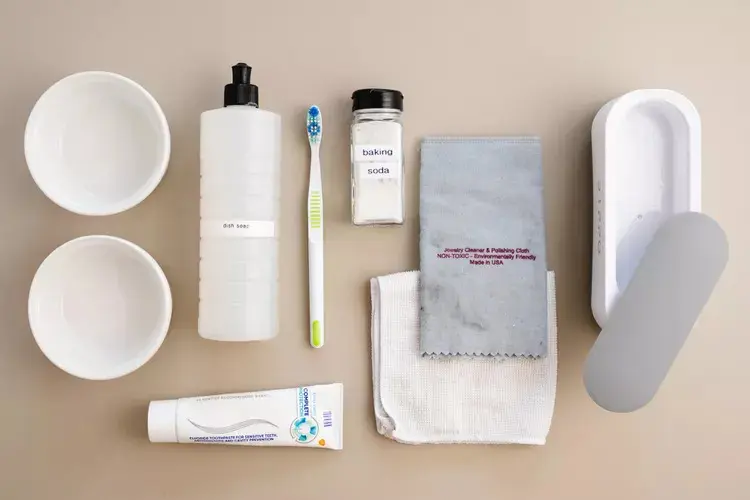
Equipment / Tools
- Two little dishes or bowls
- Toothbrush with soft bristles
- Microfiber fabric
- Cloth for polishing
- Ultrasonic jewelry cleanser
Materials
- Mild dishwashing liquid
- Baking soda
- Non-whitening paste toothpaste
Cleaning With Soap and Water
This is the easiest method to use to clean your stainless steel jewelry of light dirt and grime and to remove dullness.
This method requires things you already have in your kitchen so everyone can use it. Warm water, soap, and a gentle cloth—such as terry cloth or microfiber—are needed for this technique. For stainless steel jewelry with light dirt and germs, it works well.
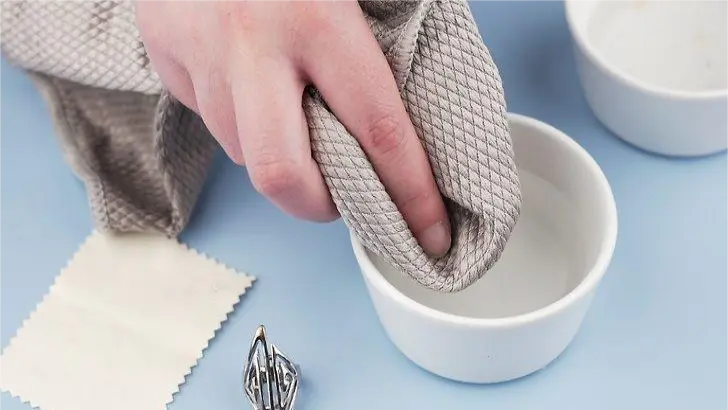
- Pour warm water into each of your two bowls.
- Add four drops of Joy or Downy mild soap to a bowl of warm water. Select a soap that is designed to be used on grease.
- Give your stainless steel object a minimum of three to five minutes to soak in the water-soap solution in the bowl. Soaking will make it easier to remove the accumulated dirt from multiple uses by softening it.
- Take the object out of the mixture basin and place it in a warm water bowl.
- Using a gentle cloth, rub it to remove any dirt or grime. Ensure you dry with the grain, not against it, to prevent scratches.
- To remove any last traces of grime, wash your artwork under running water.
Cleaning With Baking Soda
Baking soda, also known as sodium bicarbonate, is a multifunctional cooking tool with many uses outside the kitchen. It’s a powerful cleaner that works well on grime and may be used to keep your favorite stainless steel jewelry pieces looking like new.
Warm water, a bowl, baking soda, a soft towel free of lint, soft bristles, and either vinegar or water are needed for this solution.
Combine three parts baking soda with one part vinegar or water to make a paste. The amount of jewelry to be cleaned will determine how much paste needs to be created.
If you want to clean many stainless steel parts, make several mixes. Recall that vinegar is meant to be an astringent cleaning solution for unclean jewelry.
Cleaning With Toothpaste
The same hard-to-reach places in your mouth that your gel toothpaste can also be cleaned in your stainless steel jewelry. Interesting, right?
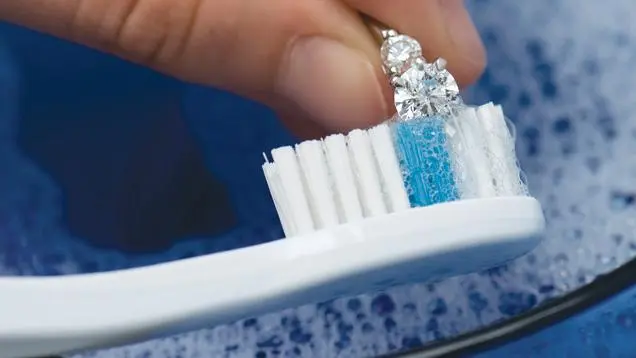
As toothpaste doesn’t scratch metal too much, it’s an effective cleaning solution for spot cleaning. Did you know that? Unfortunately, it won’t work for polishing because it isn’t abrasive enough.
In that instance, you can use baking soda or vinegar. Water, gel toothpaste, and a soft-bristle toothbrush are required for this procedure.
Cleaning With Homemade Cleaner
Using a homemade cleaner that only requires a household staple — club soda—is one way to give your stainless steel jewelry a thorough cleaning and a nice shine.
Dish soap and club soda are the only two items for this approach. It will bring back the brilliance of your accessory and the sapphires, diamonds, and turquoise gemstones in your jewelry.
Your pieces become cleaner due to the carbonation process, which removes grease and residue.
Cleaning With Aluminium Foil
This technique creates a simple DIY jewelry cleaning solution by combining aluminum foil and baking soda, such as sodium bicarbonate.
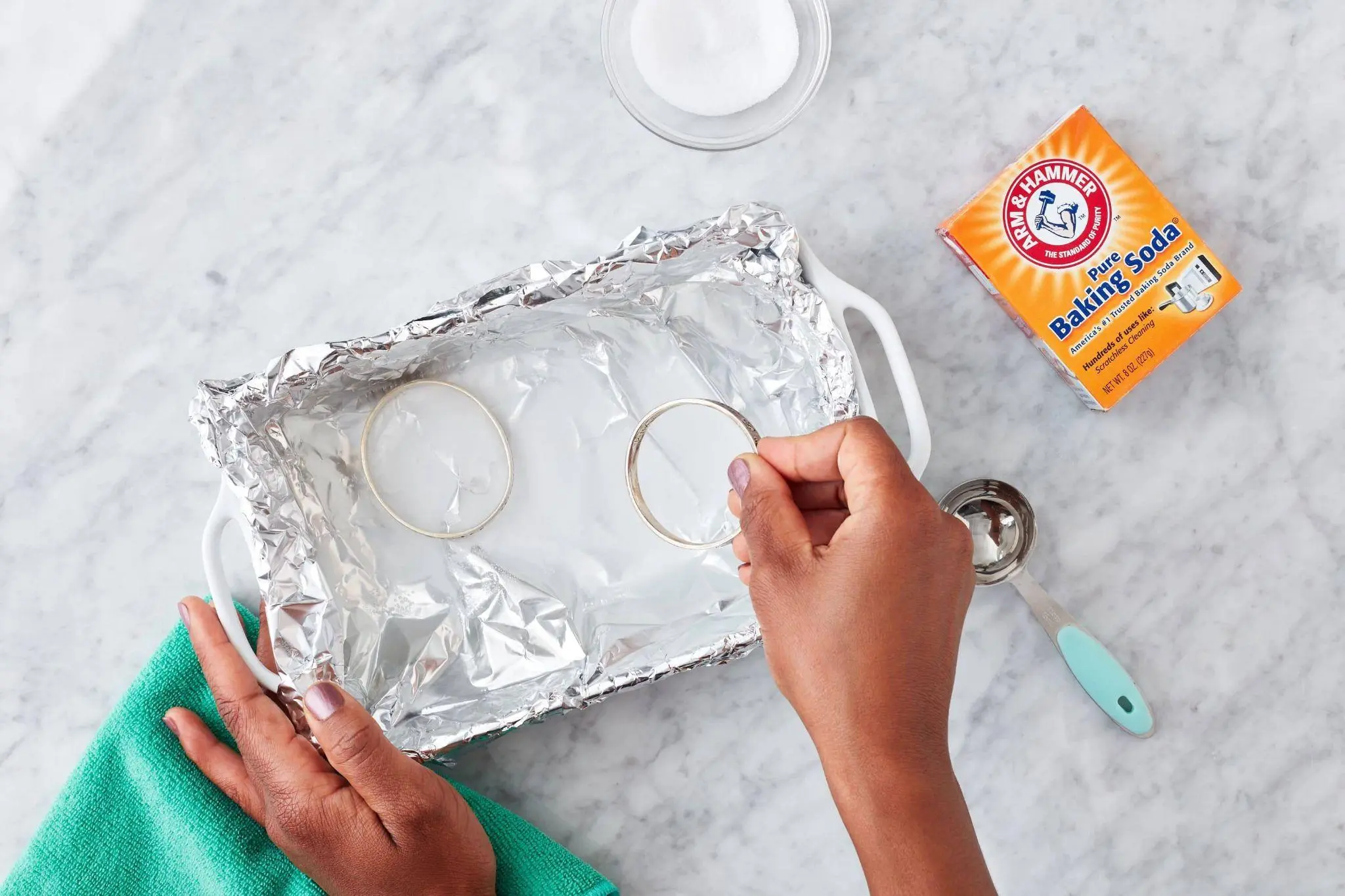
Baking soda ionization is the method used; it’s essentially a chemical reaction that breaks down oils and grime and extracts them from the jewelry.
A dish or bowl, a toothbrush with soft bristles, hot water, dish soap, aluminium foil, and salt are required for this cleaning method.
Since the solution is reactive and less acidic than the vinegar and baking soda mixture covered later, it is also considered a safer choice.
Cleaning With Vinegar
For a more thorough cleaning that also functions as a disinfectant for your stainless steel item by eliminating contaminants, you want to use the vinegar solution.
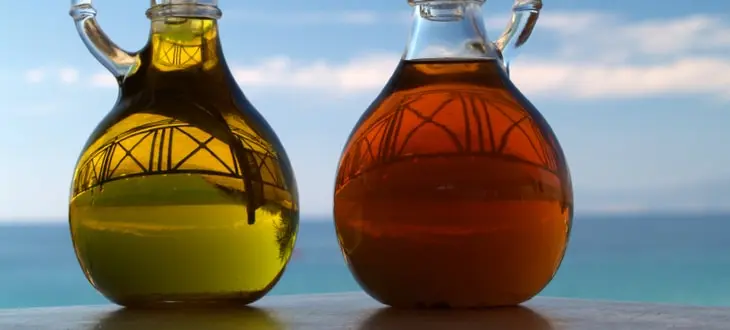
You will need water, white vinegar, and a soft, lint-free cloth for both methods. The first method works well for thorough cleaning but requires a bowl.
Spot clothing works well with the second option, although it does need a spray bottle. Your accessory will no longer be tarnished with one of these techniques.
Method 1 – Bowl Option
Transfer the blend of vinegar and water into a bowl.
Let the stainless steel object soak in the liquid for fifteen to thirty minutes. Your jewelry must soak in the solution over a more extended period, the dirtier it is.
When fifteen to thirty minutes have passed, take your accessory out of the liquid.
To remove any visible dirt particles, rinse your item with the maximum water pressure from your sink.
Lastly, you can wipe your piece with a delicate cloth free of lint. To avoid scratches, gently dry it with the grain facing up.
Method 2 – Spray Bottle Option
Fill a clean spray bottle with the water and vinegar mixture.
Along with the mixture, mist a lint-free cloth.
Rub the item with the cloth, being sure to move with the grain rather than against it. To bring back the glimmer of the jewelry, gently scrub any sticky or dull places.
Use a dry portion of the soft fabric to pat dry your piece, or use a fresh cloth if necessary.
How to Care for Stainless Steel Jewelry
There are numerous ways to maintain the sparkle of your stainless steel jewelry. Here are some ideas for you to think about.
As needed, give your jewelry a polish
Does the flash on your stainless steel accessory need to be brought out with additional polishing? A microfibre cloth dipped in a dab of olive oil can gently rub the jewelry. Thanks to that simple fix, the metal will maintain its lovely sheen and brilliance.
Beware of using bleach or chlorine
Since the metal isn’t reactive; strong chemicals will discolor your jewelry and maybe lead to rust.
Properly store your jewelery
Although stainless steel is not prone to tarnish or rust, it must be stored properly to keep it clean and avoid scratches and a dull appearance.
If you no longer have the package, store it in the cloth box it originally came in or in cloth pouches. If you don’t have cloth pouches, another good option is to store them in sealed zip-lock bags.
Considering each metal has a different hardness, be careful not to store it with jewelry of other metals.
Stainless Steel Jewelry Care FAQs
Will stainless steel jewelry rust?
Unlike brass, gold plating, or sterling silver necklaces, stainless steel necklaces do not rust or tarnish. Stainless steel is mainly composed of steel and chromium, with trace amounts of other elements occasionally present. The chemical ingredient that gives the steel its protective covering is chromium.
Can I wear stainless steel jewelry to the beach, pool, & in the shower?
You can, certainly. Without seriously harming the ornamentation, you can safely wash your hands with a stainless steel ring and shower with stainless steel jewelry. Water may not damage anything, but powerful chemicals can.
What can I use to clean my stainless steel jewelry?
You can use many things to clean your stainless steel jewelry, such as soap and water, baking soda, toothpaste, aluminium foil, or vinegar.
How often should I clean my jewelry?
You should clean your jewelry at least once a week to keep it looking nice. To prevent introducing additional bacteria to your skincare routine, remove your jewelry before applying makeup, showering, and using different skin care products. Every six months, you should get your jewelry professionally cleaned. As a preventative measure, use a jewelry polishing cloth in between cleanings.
